Eiger
| Eiger | |
|---|---|
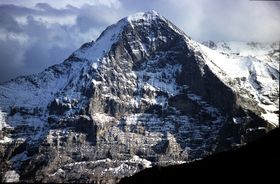 The north face of the Eiger |
|
| Elevation | 3,970 m (13,025 ft) |
| Prominence | 356 m (1,168 ft) [1] |
| Parent peak | Mönch |
| Location | |
 Eiger
|
|
| Location | Switzerland |
| Range | Bernese Alps |
| Topo map | Swisstopo 1229 Grindelwald |
| Climbing | |
| First ascent | 11 August 1858 |
| Easiest route | basic rock/snow/ice climb |
The Eiger (3,970 m (13,025 ft.)) is a mountain in the Bernese Alps in Switzerland. It is the easternmost peak of a ridge-crest that extends across the Mönch to the Jungfrau at 4,158 m. The northern side of the mountain rises about 3 km above Grindelwald and other inhabited valleys of the Bernese Oberland, and the southern side faces the deeply glaciated region of the Jungfrau-Aletsch, covered by some of the largest glaciers in the Alps.
The first ascent of the Eiger was made by Swiss guides Christian Almer and Peter Bohren and Irishman Charles Barrington, who climbed the west flank on 11 August 1858. The north face (German: Nordwand) was not climbed until 1938 by an Austrian-German expedition and is one of the six Great north faces of the Alps,[2] towering over 1,800 m (5,900 ft) above the valley of Grindelwald. Since 1935, at least sixty-four climbers have died attempting the north face, earning it the German nickname, Mordwand, or "death wall".[3]
From Kleine Scheidegg a railway tunnel runs inside the Eiger and two internal stations provide easy access to viewing-windows in the mountainside. The railway terminates in the Jungfraujoch, between the Mönch and the Jungfrau, at the highest railway station in Europe.
The Eiger is mentioned in records dating back to the 13th century but there is no clear indication of how exactly the peak gained its name. The three mountains of the ridge are commonly referred to as the Virgin (German: Jungfrau, lit. "Young Woman" - translates to "Virgin" or "Maiden"), the Monk (Mönch) and the Ogre (Eiger). The name has been linked to the Greek term akros, meaning "sharp" or "pointed", but more commonly to the German eigen, meaning "characteristic".
Contents |
Geographic setting and description
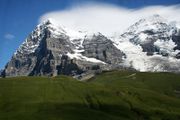
The Eiger is located 5.5 km northeast of the Jungfrau, in the northeastern part of the Bernese Alps. At the same distance to the north lies the village of Grindelwald, which is about 20 km from Interlaken. Other close settlements lie to the west, in the valley of Lauterbrunnen. The Eiger rises in one continuous pile of rock, so steeply that scarcely a patch of snow can cling to its flanks, nearly 3.000 m. above the river Schwarze Lütschine that flows from the Lower Grindelwald Glacier at its eastern base. The mountain does not properly form part of the main chain of the Bernese Alps. It is a huge limestone buttress, projecting from the granitic mass of the Mönch across the Eigerjoch, and the glaciers on either flank feed two branches of the same stream — the Lütschine — that flow together to the Aar.
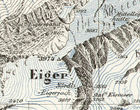
The massive wall of the Jungfrau, Mönch and Eiger itself is, from many places on the north side of the Swiss Alps, the most visible massif of the Bernese Alps, thus making the region a major tourist destination in the Alps. The higher Finsteraarhorn (4,270 m) and Aletschhorn (4,190 m), which are located about 10 km to the south, are generally less visible and situated in the middle of glaciers in less accessible areas. The south side of the massif consists only of large glaciers: Aletsch, Fiesch and Lower Grindelwald and is thus uninhabited. The whole area, the Jungfrau-Aletsch, comprising the highest summits and largest glaciers of the Bernese Alps, was inscribed as a UNESCO World Heritage Site in 2001.
In July 2006, a piece of the Eiger, amounting to approximately 700,000 cubic metres of rock, fell from the east face. As it had been noticeably cleaving for several weeks and fell into an uninhabited area, there were no injuries and no buildings were hit.[4]
The Nordwand
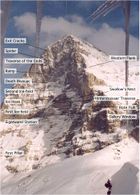
The Nordwand, German for "north face", is the spectacular north (or, more precisely, northwest) face of the Eiger (also known as the Eigernordwand: "Eiger north face"). It is one of the six great north faces of the Alps, towering over 1,800 m (5,900 ft) above the valley in the Bernese Oberland below. At 2,866 metres inside the mountain lies the Eigernordwand railway station. The station is connected to the north face by a hole, which has sometimes been used to rescue climbers.
It was first climbed on 24 July 1938 by Anderl Heckmair, Ludwig Vörg, Heinrich Harrer and Fritz Kasparek, a German–Austrian group. The group had originally consisted of two independent teams; Harrer and Kasparek were joined on the face by Heckmair and Vörg, who had started their ascent a day later and had been helped by the fixed rope that the lead group had left across the Hinterstoisser Traverse. The two groups, led by the experienced Heckmair, co-operated on the more difficult later pitches, and finished the climb roped together as a single group of four.
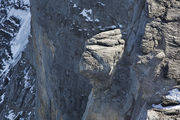
A portion of the upper face is called "The White Spider", as snow-filled cracks radiating from an ice-field resemble the legs of a spider. Harrer used this name for the title of his book about his successful climb, Die Weisse Spinne (translated into English as The White Spider: The Classic Account of the Ascent of the Eiger). During the first successful ascent, the four men were caught in an avalanche as they climbed the Spider, but all had enough strength to resist being swept off the face.
Since then, the north face has been climbed many times. Today it is regarded as a formidable challenge more because of the increased rockfall and diminishing ice-fields than because of its technical difficulties, which are not at the highest level of difficulty in modern alpinism (K2 and Nanga Parbat are more difficult). In summer the face is often unclimbable because of rockfall, and climbers are increasingly electing to climb it in winter, when the crumbling face is strengthened by ice.
Since 1935, at least sixty-four climbers have died attempting the north face, earning it the German nickname, Mordwand, or "murder wall", a play on the face's German name Nordwand.[3]
Climbing history
While the summit was reached without much difficulty in 1858 by a complex route on the west flank, the battle to climb the north face has captivated the interest of climbers and non-climbers alike. Before it was successfully climbed, most of the attempts on the face ended tragically and the Bernese authorities even banned climbing it and threatened to fine any party that should attempt it again. But the enthusiasm which animated the young talented climbers from Austria and Germany finally vanquished its reputation of unclimbability when a party of four climbers successfully reached the summit in 1938 by what is known as the "1938" or "Heckmair" route.
The climbers that attempted the north face could be easily watched through the telescopes from the Kleine Scheidegg, a pass between Grindelwald and Lauterbrunnen connected by rail. The contrast between the comfort and civilization of the railway station and the agonies of the young men slowly dying a short distance away led to intensive coverage by the international media.
After World War II, the north face was climbed twice in 1947: first by a party of two French guides, Louis Lachenal and Lionel Terray, then by a Swiss party consisting of H. Germann, with Hans and Karl Schlunegger.[5]
First ascent
The first ascent was made by the western flank on 11 August 1858 by Charles Barrington with guides Christian Almer and Peter Bohren. They started at 3:00 p.m. from Wengen . Barrington describes the route much as it is followed today, staying close to the edge of the north face much of the way. They reached the summit at about noon, stayed for some 10 minutes and descended in about four hours. Barrington describes the reaching of the top, saying: "the two guides kindly gave me the place of first man up". Their ascent was confirmed by observation of a flag left on the summit. According to Harrer's The White Spider, Barrington was originally planning to make the first ascent of the Matterhorn, but his finances did not allow him to travel there as he was already staying in the Eiger region.[6]
Attempts on the north face
1935
In 1935 two young German climbers from Bavaria, Karl Mehringer and Max Sedlmeyer, arrived at Grindelwald to attempt to climb the face. They waited a long time for good weather and when the clouds finally cleared they started. The two climbers reached the height of the Eigerwand station and had their first bivouac. On the following day, because of the greater difficulties, they gained little height. On the third day, they hardly made any vertical ground. At night a storm broke and the mountain was hidden in fog; then it began to snow. Avalanches of snow began to sweep the face and the clouds closed over it. Two days later, there was a short moment when the clouds cleared and the mountain was visible for a while. People obtained a glimpse of the two men, who were now a little higher and about to bivouac for the fifth time. Then the fog came down again and hid the climbers. A few days later the weather finally cleared, revealing a completely white north face. The two climbers were found later frozen to death at 3,300 m, at a place now known as "Death Bivouac".[5][7]
1936
The next year ten young climbers from Austria and Germany came to Grindelwald and camped at the foot of the mountain. Before their attempts started, one of them was killed during a training climb, and the weather was so bad during that summer that after waiting for a change and seeing none on the way, several members of the party gave up. Of the four that remained, two were Bavarians, Andreas Hinterstoisser and Toni Kurz, the youngest of the party, and two were Austrians, Willy Angerer and Edi Rainer. When the weather improved they made a preliminary exploration of the lowest part of the face. Hinterstoisser fell 120 feet but was not injured. A few days later the four men finally began the ascent of the face. They climbed quickly, but on the next day, after their first bivouac, the weather changed; clouds came down and hid the group to the observers. They did not resume the climb until the following day, when, during a break, the party was seen descending, but the climbers could only be watched intermittently from the ground. The weather then deteriorated for two days. Three guides started on an extremely perilous rescue. They failed to reach them but came within shouting distance, finding that only one climber, Toni Kurz, was still alive. He explained that his three companions had died the day before. One had fallen down the face, another was frozen above him, the third had fractured his skull in falling, and was hanging dead on the rope.[5]
In the morning the three guides came back, traversing across the face from a hole near the Eigerwand station and risking their lives under incessant avalanches. Toni Kurz was still alive but almost helpless, with one hand and one arm completely frostbitten. The guides were not able to pass an unclimbable overhang that separated them from Kurz. The latter tried for hours to reach his rescuers who were only a few metres below him. Then he began to lose consciousness. One of the guides, climbing on another's shoulders, was able to touch the tip of Kurz's crampons with his ice-axe but could not reach higher. Kurz was unable to descend farther and, completely exhausted, died slowly.[5]
1937
An attempt was made in 1937 by Matthias Rebitsch and Ludwig Vörg. Although the attempt was unsuccessful, they were nonetheless the first climbers who returned back alive from a serious attempt on the face. They started the climb on 11 August and reached a high point of a few rope lengths above Death Bivouac. A storm then broke and after three days on the wall they had to retreat. This was the first successful withdrawal from a significant height on the wall.[8]
First ascent of the north face
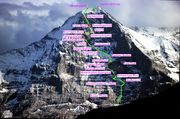
The north face was first climbed on 24 July 1938 by Anderl Heckmair, Ludwig Vörg, Heinrich Harrer and Fritz Kasparek of a German–Austrian party. The party had originally consisted of two independent teams: Harrer (who didn't have a pair of crampons on the climb) and Kasparek were joined on the face by Heckmair and Vörg, who had started their ascent a day later and had been helped by the fixed rope that the lead team had left across the Hinterstoisser Traverse. The two groups, led by the experienced Heckmair, decided to join their forces and roped together as a single group of four. Heckmair later wrote: "We, the sons of the older Reich, united with our companions from the Eastern Border to march together to victory".[5]
The expedition was constantly threatened by snow avalanches and climbed as quickly as possible between the falls. On the third day a storm broke and the cold was intense. The four men were caught in an avalanche as they climbed "the Spider", the snow-filled cracks radiating from an ice-field on the upper face, but all possessed sufficient strength to resist being swept off the face. The members successfully reached the summit at four o'clock in the afternoon. They were so exhausted that they only just had the strength to descend by the normal route through a raging blizzard.[5]
Other routes
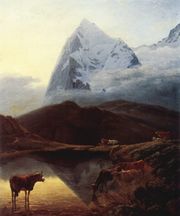
- 1858: First ascent by the west flank, 11 August (Charles Barrington, Christian Almer and Peter Bohren). According to Harrer's "The White Spider", Barrington would have performed the first Matterhorn ascent instead, but his finances did not allow him to travel there as he was already staying in the Eiger region.
- 1871: First ascent by the southwest ridge, 14 July (W. A. B. Coolidge, Meta Brevoort, Christian Bohren, Christian Almer and Ulrich Almer).
- 1890: First ascent in winter, by Mead and Woodroffe, with guides Ulrich Kaufmann and Christian Jossi.
- 1921: 10 September: First ascent via the Mittellegi ridge by Fritz Amatter, Samuel Brawand, Yuko Maki and Fritz Steuri.
- 1924: First ski ascent via the Eiger glacier.
- 1932: First ascent via the Lauper route on the northeast face.
- 1970: First ski descent, on the west flank, by Sylvain Saudan.
- 1992: 18 July: Three BMG/UIAGM/IFMGA clients died in a fall down the West Flank: Willie Dunnachie, Edward Gaines and Phillip Davies.
- 2006: 14 June: François Bon and Antoine Montant make the first speedflying descent of the Eiger.[9][10]
- 2006: 15 July: Approximately 20 million cubic feet (700,000 cubic metres) of rock from the east side collapses. No injuries or damage are reported.[11]
Climbs and attempts on the north face
1930s and 1940s
- 1934: First attempt on the face, by Willy Beck, Kurt Löwinger and Georg Löwinger, reaching 2,900 m.
- 1935: First attempt by the Germans Karl Mehringer and Max Sedlmeyer. They freeze to death at 3,300 m, a place now known as "Death Bivouac".
- 1936: Four Austrian and German climbers, Andreas Hinterstoisser, Toni Kurz, Willy Angerer and Edi Rainer, die on the face in severe weather conditions during a retreat from Death Bivouac.
- 1938: Alpine Journal editor Edward Lisle Strutt calls the face 'an obsession for the mentally deranged' and 'the most imbecile variant since mountaineering first began'.[12]
- 1938: First ascent of the north face by Anderl Heckmair, Heinrich Harrer, Fritz Kasparek and Ludwig Vörg, achieved in three days.
- 1947: Second ascent of the face by Frenchmen Lionel Terray and Louis Lachenal.
1950s
- 1950: First one-day ascent of the face by Leo Forstenlechner and Erich Wascak, in 18 hours.[13]
- 1957: Two Italian (Claudio Corti and Stefano Longhi) and two German climbers (Franz Meyer[14] and Gunther Nothdurft) encounter extreme difficulties in the higher part of the route, as Nothdurft becomes ill and Longhi, who is suffering from severe frostbite, falls near "the Spider" and cannot be lifted by his companions. Corti (who has been in turn hit by a falling stone) becomes the first man rescued from the face from above in famous 54-men rescue action (firstly undertaken by volunteer climbers and non-Swiss guides) when German guide Alfred Hellepart is lowered from the summit on a steel cable by Ludwig Gramminger's (de:Ludwig Gramminger) rescue system. Longhi is not so lucky, and dies of exposure before he can be rescued [15]. Meyer and Nothdurft died in an avalanche on their descent of the Eiger's west face after completing the 13th ascent of the north face (they had left the injured Corti with all their provisions – including a small tent – and were trying to descend from the mountain and call rescue). The body of Longhi remains on the face for more than two years before being recovered.[16]
- 1958: Kurt Diemberger and Wolfgang Stefan make the thirteenth ascent. As the bodies of Nothdurft and Meyer were found later on the descent route from the Eiger – both have been killed by an avalanche – Diemberger and Stefan were finally awarded the 14th ascent of the face
- 1959: Adolf Derungs and Lucas Albrecht, two Swiss masons, climb the face with very primitive equipment. Derungs wore four shirts one on top of another and Albrecht carried an old overcoat as far as the Spider. Both students, brave to the point of rashness and very tough, descend by night by the west flank. Three years later, in 1962, Derungs disappears whilst attempting a solo ascent of the north face.
1960s
- 1961: March 6–12: First winter ascent of the face by Toni Kinshofer, Anderl Mannhardt, Walter Almberger and Toni Hiebeler.
- 1961: First all-Czechoslovak ascent of the face by Radovan Kuchař and Zdeno Zibrín (19th overall, 30 Aug - 2 Sept) [17].
- 1961: First all-Polish ascent of the face by Stanisław Biel and Jan Mostowski (20th overall, 31 Aug - 2 Sept) [17].
- 1962: First all-Italian ascent of the face by Armando Aste, Pierlorenzo Acquistapace, Gildo Airoldi, Andrea Mellano, Romano Perego, and Franco Solina.
- 1962: First all-British ascent of the face by Chris Bonington and Ian Clough.
- 1962: Two very young men who successfully climbed the face are arrested when they arrive back at the its foot. A distraught mother had informed the police of her sons inexperience at mountaineering. (Searching for names)
- 1963: 2–3 August: First solo ascent of the face by Michel Darbellay, in around 18 hours of climbing.
- 1963: 15 August 15: Two Spanish climbers die in a storm, Ernesto Navarro and Alberto Rabadá.
- 1963: 27–31 December: Three Swiss guides complete the first descent of the face, retrieving the bodies of Ernesto Navarro and Alberto Rabadá from the "White Spider".
- 1964: 1–3 September: German Daisy Voog becomes the first woman to reach the summit via the face (with Werner Bittner).
- 1966: March 22: After a fixed rope breaks, American John Harlin falls to his death while making an ascent of the face by the new route: the direttissima, or "most direct" route. His colleagues in the same team, Dougal Haston, Siegi (Siegfried) Hupfauer, Jörg Lehne, Günter Strobel and Roland Votteler, push on to complete the first direttissima ascent (summit on 25 March 25, after one month's siege), which is named the "John Harlin Route" in his honour.
- 1968:28–31 July: First ascent of the north ridge, by a Polish team: Krzysztof Cielecki, Tadeusz Łaukajtys, Ryszard Szafirski, Adam Zyzak [18][19].
1970s
- 1970: Leo Dickinson, Eric Jones, Pete Minks and Cliff Phillips (GB) make the first complete film of the climb.
- 1971: First all-Belgian ascent of the face by Renaat Van Malderen and Vincent de Waele.
- 1971: Peter Siegert and Martin Biock are winched from above Death Bivouac to a helicopter, the first such successful rescue.
- 1974: Reinhold Messner and Peter Habeler climb the face in 10 hours.
- 1976: First alpine-style ascent of the Eiger Direct (Harlin Route) by Alex MacIntyre (UK) and Tobin Sorenson (USA).[20]
- 1977: First Dutch ascent of the face by Ronald Naar and Bas Gresnigt.
1980s
- 1981: First British solo ascent of the face by Eric Jones - filmed by Leo Dickinson and released as Eiger Solo.
- 1981: 25 August: Swiss guide Ueli Bühler soloes the face in 8 hours and 30 minutes.
- 1982: Slovene Franček (Franc) Knez soloes the face in 6 hours
- 1982 First American winter ascent by Harry Kent.
- 1983: 21 March–2 April (13 days in the wall): First winter solo ascent and new route on the face (the ideal direttissima) by Slovak Pavel Pochylý sk:Pavel Pochylý.[21].
- 1983: 27 July: Austrian Thomas Bubendorfer soloes the face without a rope in 4 hours and 50 minutes, almost halving Bühler's time.
- 1984: 21 July: Slovene Slavko (Miroslav) Svetičič. Classic route, solo climb in 8 hours.
1990s
- 1990: 14–15 January: Slavko Svetičič solo climbs the Harlin route in 26 hours, its first winter ascent.
- 1992: Jeff Lowe (climber) solos Metanoia on the north-east face.
- 1992: 10 March: Catherine Destivelle (France) soloes the face in 17 hours. It is the first solo woman's ascent of such a serious and dangerous Alpine face.[22].
- 1997: Benedetto Salaroli, aged 72, becomes the oldest man to climb to the face. He climbs it in a single day with guides Ueli Buhler and Kobi Reichen
2000s
- 2003: 24 March: Italian Christoph Hainz breaks Bubendorfer's record by ten minutes, climbing the face in 4 hours and 40 minutes.
- 2007: 9 April: Christophe Profit, a French mountain guide, guides the face for the tenth time.
- 2007: 21 February: Swiss alpinist Ueli Steck breaks Christoph Hainz's record, soloing the face in 3 hours and 54 minutes.[13]
- 2008: 28 January: Swiss mountaineers Roger Schäli and Simon Anthamatten set a new record for a team ascent (of the Heckmair route) climbing it in 6 hours and 50 minutes.
- 2008: 13 February: Ueli Steck breaks his own record, soloing the face in 2 hours, 47 minutes and 33 seconds.[23]
- 2008: 23 February: Swiss mountaineers Daniel Arnold and Stephan Ruoss better the team record (Schäli and Anthamatten), climbing the Heckmair route in 6 hours, 10 minutes.[24]
- 2008: 31 May: Swiss alpinist Ueli Steck is presented with the inaugural Eiger Award.[25]
- 2008: 7 August: Dean Potter (USA) free-solos Deep Blue Sea (5.12+) on the face, then BASE jumps from the top using an ultralight rig he wore during the climb.
Panorama
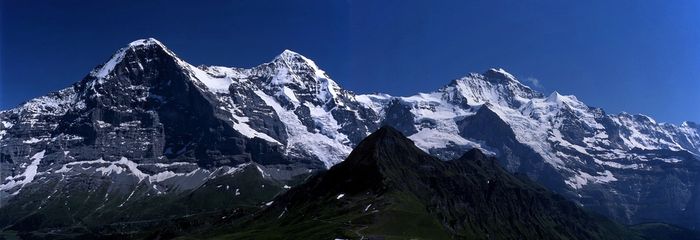
Popular culture
- The 1972 novel The Eiger Sanction is an action/thriller novel by Rodney William Whitaker (writing under the pseudonym Trevanian), based around the climbing of the Eiger. This was then made into a 1975 film starring Clint Eastwood and George Kennedy. The Eiger Sanction film crew included very experienced mountaineers (e.g. John Cleare, Dougal Haston, and Hamish MacInnes, see Summit, 52, Spring 2010) as consultants, in order to ensure accuracy in the climbing footage, equipment and techniques.
- The 1980 novel Traverse Of The Gods by English author Bob Langley is a World War II climbing thriller set on the mountain.
- The 1982 book Eiger, Wall of Death by Arthur Roth is a historical account of first ascents of the north face.[26]
- The 1997 book The Power of Now by Eckhart Tolle mentions the Eiger in chapter 3.[27] The Eiger is mentioned in a comparison of extreme danger in physical activities versus the ease with which one may directly enter a state of intense consciousness in the mind through total awareness of the present.[27]
- Eiger Dreams, a collection of short stories by Jon Krakauer, begins with an account of Krakauer's own attempt to climb the north face.
- Eiger (as well as Jungfrau) are callsigns for European Federation tank units in the game Tom Clancy's Endwar.
- Eiger was mentioned in song "Abandonfire" from second Roger Taylor's solo studio album Strange Frontier.
- The track Eiger Nordwand in the game Gran Turismo HD Concept and Gran Turismo 5 Prologue is set in Kleine Scheidegg. Interestingly this is despite the fact that the location is actually a car-free zone. Although motor racing was illegal in Switzerland for over 50 years, the ban was lifted in 2007[28].
- Skiers Shane McConkey and J. T. Holmes "skibase"-jumped off the western flank of the north face. This footage can be seen in the film Yearbook by Matchstick Productions.
- The Eiger was the name of the first song on 2005 album The Wedding by the rock band Oneida.
- The IMAX film The Alps features John Harlin III's climb up the north face in September 2005. Harlin's father, John Harlin II, set out 40 years earlier to attempt a direct route (the direttissima) up the 6,000-foot (1,800 m) face, the so-called "John Harlin route". At 4,000 feet (1,200 m), his rope broke, and he fell to his death. James Swearingen created a piece named Eiger: Journey to the Summit in memory of him.
- The 2007 docu/drama film The Beckoning Silence features mountaineer Joe Simpson, of Touching the Void fame, recounting – with filmed reconstructions – the ill-fated 1936 expedition up the north face of the Eiger and how it inspired him to take up climbing. The film followed Simpson's 2003 book of the same name, which covered the same subject among musings on broader mountaineering topics. Those playing the parts of the original climbing team were Swiss mountain guides – Roger Schäli (Toni Kurz), Simon Anthamatten (Andreas Hinterstoisser), Dres Abegglen (Willy Angerer) and Cyrille Berthod (Edi Rainer).
- Nordwand, a 2008 German/Swiss/Austrian feature film directed by Philipp Stölzl, recreates the fatal 1936 attempt by Hinterstoisser's party.[29]
- Paul Muldoon's poem 'The Electric Orchard', from the 1973 collection New Weather, mentions the Eiger in the lines 'The North Wall/Of the Eiger was notorious for blizzards,'[30]
See also
- Bernese Oberland
Filmography
- Nordwand Philipp Stölzl 2008
References
- ↑ Swisstopo maps
- ↑ Reinhold Messner, The big walls: from the North Face of the Eiger to the South Face of Dhaulagiri, p. 41
- ↑ 3.0 3.1 Venables, Stephen (2006-08-27). "The Eiger is my kind of therapy". London: The Sunday Times. http://www.timesonline.co.uk/tol/news/article620497.ece. Retrieved October 26, 2008.
- ↑ The Associated Press (2008-07-14). "Massive chunk falls from Swiss mountain". MSNBC. http://www.msnbc.msn.com/id/13856484/. Retrieved October 26, 2008.
- ↑ 5.0 5.1 5.2 5.3 5.4 5.5 Claire Eliane Engel, A history of mountaineering in the Alps, 1950
- ↑ First ascent of the Eiger summitpost.org. Retrieved 2010-03-03
- ↑ The north face of the Eiger mountainzone.com. Retrieved on 2010-03-04
- ↑ Alptraum der Alpen einestages.spiegel.de. Retrieved on 2010-03-04
- ↑ Acro-base.com video
- ↑ You tube video of the descent
- ↑ bioedonline.org
- ↑ From Strutt's Presidential Valedictory Address, 1938, in Alpine Journal, Vol. L, reprinted in Peaks, Passes and Glaciers, ed. Walt Unsworth, London: Allen Lane, 1981, p. 210
- ↑ 13.0 13.1 Alpinist.com Ueli Steck shatters Eiger record
- ↑ "Strange and dangerous dreams: the fine line between adventure and madness", Geoff Powter, 2006, p. 165.
- ↑ Skoczylas, Adam (1962). Stefano, we shall come tomorrow. London: Poets' and Painters' Press. pp. 35., en [the story about the 1957 rescue action]
- ↑ Claudio Corti (1928-2010): A Life in the Shadow of the Eiger en, article by Luca Signorelli. Retrieved 2010-03-16
- ↑ 17.0 17.1 wspinanie.pl, Eiger part 3, Polish ascents (→1961 Droga Klasyczna) pl. Retrieved 2010-03-16; earlier reference, see: "Taternik" No 3-4/1966, pl
- ↑ wspinanie.pl, Eiger part 2, routes, N Pillar/ridge pl. Retrieved 2010-03-16
- ↑ wspinanie.pl, Eiger part 3, Polish ascents (→1968) N Pillar pl. Retrieved 2010-03-16
- ↑ Scott, Doug; Alex MacIntyre (2000 (reprint edition); original 1984). Shisha Pangma: The Alpine Style First Ascent of the South-West Face. Seattle, WA, USA: The Mountaineers Books. ISBN 0-89886-723-1.
- ↑ wspinanie.pl Eiger part 2, routes (Pochylý solo) pl. Retrieved 2010-03-16
- ↑ destivelle.com, Catherine Destivelle solo ascents, Eiger Retrieved 2010-03-16. Available also in French
- ↑ Planetmountain News
- ↑ Alpinist.com Eiger Team sets Record
- ↑ Ueli Steck scales new heights with 2008 Eiger award
- ↑ Roth, Arthur (1982)"Eiger, wall of death". Norton. ISBN 0393014967 and (2000) Adventure Library. ISBN 1885283199.
- ↑ 27.0 27.1 Tolle, Eckhart (1999). The Power of Now: A Guide to Spiritual Enlightenment. New World Library. pp 36-37. ISBN 978-1-57731-152-2
- ↑ http://www.duemotori.com/news/f1/13619_Switzerland_lifts_motor_racing_ban.php
- ↑ Nordwand on IMDB
- ↑ Paul Muldoon, 'The Electric Orchard', in Poems 1968-1998 (London: Faber and Faber, 2001) p.3 ll. 23-24
- Anker, Daniel (ed.) Eiger: The Vertical Arena, Seattle: The Mountaineers, 2000
- Harrer, Heinrich, The White Spider: The History of the Eiger's North Face, translated from German, London, 1959 (revised 1965, 1979)
- David Pagel, My Dinner with Anderl, Ascent, AAC Press, Golden, CO, 1999, pages 13–26.
- Joe Simpson, The Beckoning Silence, Jonathan Cape Publ., London 2002, ISBN 0-09-942243-3, The Mountaineers, Seattle 2003, ISBN 0-898869412, pp. 315.
External links
- The Eiger on Summitpost
- The Eiger on Peakware - photos
- Live webcam view of the Eiger north face
- New and Old Explorations of the Eiger, Photos & Video
- Ueli Steck wins inaugural Eiger Award 2008
- Are you still here? A bagman's view of climbing the Eigerwand, by Charles Sherwood.
|
||||||||||||||||